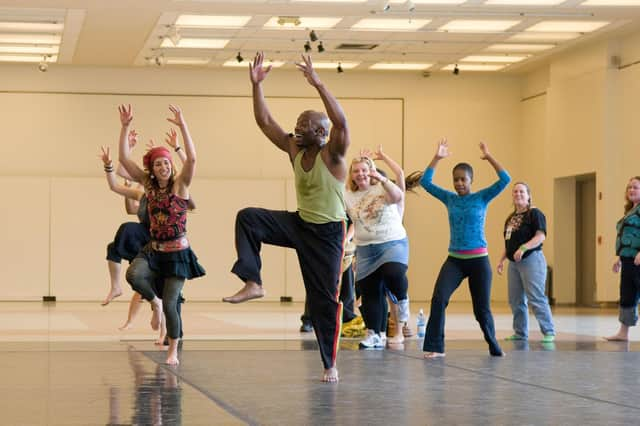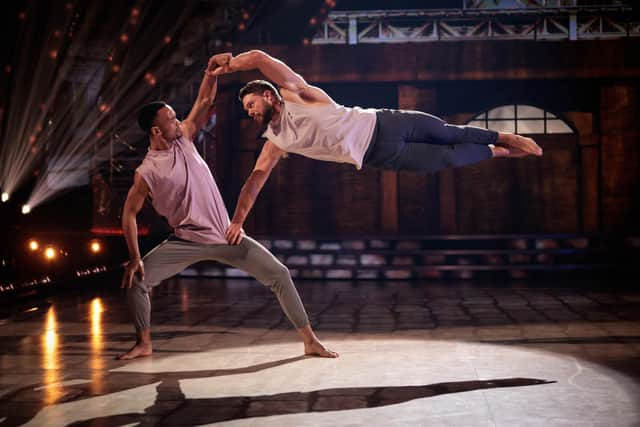How Strictly Come Dancing is inspiring more people to dance and encouraging greater diversity


If the glitzy competition has got you in the mood for dancing, there are lots of reasons to start shimmying – whatever your age or ability.
In fact, former Strictly champion Ore Oduba is supporting the Move Into Christmas campaign with care home provider Anchor aiming to get older people dancing. The TV presenter says: “The thing about dance is that it just makes you feel good, and it can really benefit your physical, mental and social wellbeing.”
Advertisement
Hide AdAdvertisement
Hide AdThere are plenty of opportunities to learn, with ClassPass (classpass.com) revealing dance sessions have entered the top 10 most popular activities booked via the site for the first time this year.


Ahead of the Strictly final, we asked a couple of professional dancers to explain how taking up dancing as a hobby can improve your health.
“Dancing increases your aerobic power and strength,” says dancer and instructor Natalie Simmonds from VAHA, the UK’s first home interactive fitness mirror. “It helps improve your balance, your posture, your flexibility – so in turn, if you’re older, it can help prevent falls, and then if you’re younger, it can help reduce any pain or stiffness you might feel from doing other activities.”
Doing dance classes alongside other fitness activities can be beneficial, because it “tones up your body in a much more natural way than many other activities, because you’re using muscles you didn’t even know existed”, explains Joelle D’Fontaine, dancer and founder of At Your Beat studios.
Advertisement
Hide AdAdvertisement
Hide AdSo what are the wellbeing benefits? “The joyful thing about dance is you’re not trying to see the physical gains, you’re just trying to have fun – and the gains are secondary. Because of this mindset, the need for ‘slimming down’ is removed – and this is great for your mind, body and your soul,” says D’Fontaine.
Just like with other forms of exercise, dancing might have “a positive and profound impact on depression, anxiety, ADHD, loads of things like that”, Simmonds suggests, plus it can impact cognitive function. “It helps to improve your memory, because you’ll be starting to remember steps and repeating them,” she adds. “It boosts your overall mood, even if you just put music on at home.”
If you dance with others, you could reap the social rewards and help fight loneliness. D’Fontaine says: “Finding a ‘dance family’ can change that around and completely help with uplifting and diversifying your social circle, with new friends helping you come out of your shell.”
Whether you’re with a partner or not, the social aspect can increase your self-esteem, too. Simmonds adds: “You can see a different confidence in people who go dancing regularly.”
Advertisement
Hide AdAdvertisement
Hide AdSo what tips can she give to beginners? “The best way to begin is to pop your favourite song on at home and just start moving your body to it, and then start to embrace that into your lifestyle as much as you can,” says Simmonds.
She suggests it’s a myth people have ‘two left feet’: “Actually, these are things we learn. We can be taught rhythm, we can be taught coordination, how to step to the beat and all these things.”
When it comes to ballroom, some dances are “more intricate and therefore you would need more lessons to really start to get your head around them”, but for beginners try the foxtrot, the rumba and waltzes.
D’Fontaine recommends trying a beginner-level cardio dance class. “This way there is no complex choreography, and you can just get used to your body moving with music and with a follow along aspect – then move onto more classes when you’re feeling the fantasy,” he says.
Advertisement
Hide AdAdvertisement
Hide Ad“When you’re in that first dance class, look to whoever is beside you just say, ‘Hello, this is my first class’. They will support you,” says D’Fontaine. Once you’ve got the hang of the basics, you could try “harder types of classes, for example heel classes, Afro beat classes or jazz classes”.
If Strictly has encouraged people to take up dancing it has also become a high profile platform that encourages diversity and inclusivity. The success of actor Rose Ayling-Ellis is shining a spotlight on an “invisible disability” and already inspiring more deaf young people to pursue careers in the arts, while at the same time her popularity has also sparked a surge of interest in sign language courses.
John Whaite and his partner Johannes Radebe have also made it into the Strictly Come Dancing final tomorrow having already made history on the show as the first all-male couple on the show, and the only same-sex couple to reach the final.
They’re only the second same-sex couple on the show ever, with Nicola Adams’ stint in the 2020 competition cut short due to Covid-19.
Advertisement
Hide AdAdvertisement
Hide AdSeeing two men dance together every Saturday night feels like a watershed moment. Even though representation in the media has improved for LGBTQ+ people, it still comes as something of a shock – particularly on such an established show such as Strictly, where the norm is for mixed-gender couples.
Whaite has been open about his Strictly journey on Instagram. “I still feel so lucky to live in a world where I can dance with another man on Saturday night television and for it to be so unquestionably accepted; for it to be about the dance and the steps we take for the 90 seconds we are on the stage,” he wrote.
That isn’t to say it’s all been smooth sailing for Whaite – he’s written about being “ready for flak” when the partnership was announced, and his most recent Instagram post is about the negativity he’s received after reaching the final.
However, he’s clear about why it’s important to see two men dancing together on prime time television.
Advertisement
Hide AdAdvertisement
Hide AdHe wrote on Instagram: “As I’ve said from day one, if even just one child watches us and feels instantly more comfortable in their own skin and more accepted by the world, then it’s all a great step forward.”
Seeing Whaite and Radebe dance joyfully and freely next to the heterosexual couples could be a source of inspiration and hope for the younger generation, showing them what’s possible.
The couple have even made their dances into powerful statements – most recently in the semi-final, when they did an emotional contemporary routine to Adele’s Hometown Glory.
Just as Ayling-Ellis is showing young deaf people that “deafness is not a barrier”, so, hopefully, Whaite and Radebe will pave the way for more same-sex couples – until it becomes par for the course, and isn’t even worth remarking on.
The Strictly Come Dancing Final 2021 takes place on December 18 at 7pm on BBC One and BBC iPlayer.
